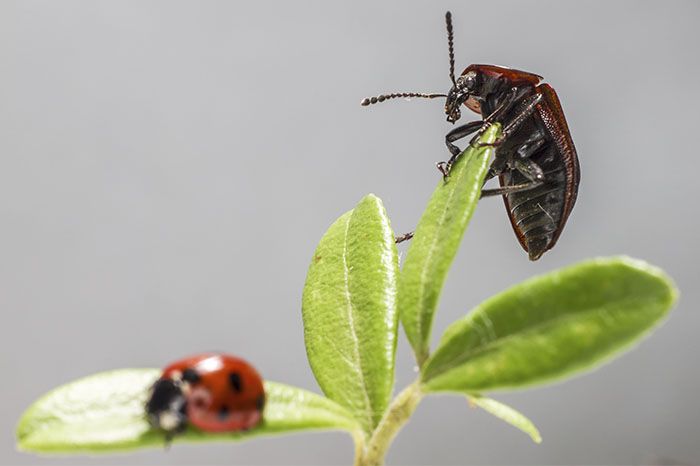Identifying Good Bugs from Bad: A Guide to Pests in Your Home and Garden

Identifying Good Bugs from Bad: A Guide to Pests in Your Home and Garden
As a homeowner, bugs are just a part of life. But knowing which ones are worth keeping around and which are best shown the door can make a huge difference in how you feel about those little visitors. While some insects can harm your plants, cause damage to your home, or even be a health hazard, others are actually helping you keep things under control. Here’s a guide to tell friend from foe in your home and garden.
Why Knowing the Difference Matters
Understanding which insects are harmful versus which ones are helpful saves you time, frustration, and money. And, honestly, it keeps you from overusing pest control products that might do more harm than good. There are insects that prey on the pests you don’t want—aphids, fleas, flies—and letting these “good guys” do their job can keep your environment in balance without much effort.
Common Beneficial Bugs to Have Around
Let’s start with the bugs you might want to encourage rather than eliminate. These insects may not always be “cute,” but they’re definitely the hidden heroes.
Ladybugs: The Aphid Busters
Ladybugs might seem like harmless little red beetles, but they’re actually aphid-devouring machines. Aphids can seriously damage your plants, especially if you love a vegetable garden. Ladybugs can save you from having to use pesticides on your plants by feasting on aphids all season long. A friend once told me her vegetable garden looked miserable until a swarm of ladybugs appeared. Within a couple of weeks, her tomatoes and cucumbers were healthy and pest-free.
Spiders: The Silent Hunters
Spiders may give you a fright now and then, but they’re also great at keeping other pests out of your home. House spiders, especially, are effective at catching flies, mosquitoes, and other tiny intruders. Sure, it can be unsettling to find one in the corner of a room, but think of them as tiny, web-spinning security guards! Just a few days ago, I noticed a small spider had set up shop near my porch light. Within hours, it had captured several insects, doing the work without me lifting a finger.
Praying Mantises: The All-Purpose Pest Patrol
Praying mantises might look strange, but they’re champions at keeping a garden healthy. They’ll snack on just about any pest that wanders into your yard, from caterpillars to beetles. They’re a little intimidating in appearance, but if you see a mantis hanging around your plants, consider it your new garden guard.
Harmful Insects to Watch Out For
On the flip side, there are pests that don’t bring any benefits and can cause quite a few headaches. These are the ones that can damage your home, your plants, and sometimes even your health.
Termites: The Wood Destroyers
Termites are small but incredibly destructive. They feast on wood, which means they can quietly damage the structure of your home, sometimes without you realizing it. Look out for signs like mud tubes on foundation walls, hollow-sounding wood, or tiny holes that termites use to enter and exit their colonies. One of our clients in Lake Norman found termites by noticing just a thin layer of “bubbling” paint on a wood beam. When we inspected further, there was serious internal damage that had to be treated.
Cockroaches: The Unwelcome Houseguests
Cockroaches are not only unsightly, but they also carry bacteria and allergens that can trigger asthma and allergies, especially in children. They’re attracted to food scraps and water, so keeping your kitchen clean and dry can help keep them away. If you see even a single roach, it’s usually a sign that more are hiding out nearby.
Carpenter Ants: The Silent Damagers
Unlike most ants, carpenter ants don’t just raid your pantry—they chew through wood to make their nests. While they don’t eat the wood like termites, they can still do a lot of damage by hollowing out structural wood beams or joists. I once inspected a home where the owner thought they had “a few ants.” It turned out the ants had hollowed out a section of an exterior wall. It’s a good reminder that some pests need more than a quick spray of ant killer.
Spotting the Signs of a Pest Infestation
So how do you know if you’re dealing with helpful insects or facing a pest problem? Here are some telltale signs.
Droppings and Frass (Wood Dust)
Insects like termites and carpenter ants leave behind tiny piles of frass (wood dust) as they tunnel through wood. Similarly, cockroaches and rodents leave droppings, which can be a health hazard. Check the darker, damper areas of your home for any signs like these.
Damage to Plants or Wood
When you notice chewed leaves or weakened wood, it’s time to take a closer look. Beneficial insects like ladybugs and mantises don’t typically cause plant damage; they’re more interested in eating the pests. But if leaves have holes or wood feels hollow, it could mean there’s a harmful pest on the scene.
Musty Odors or Noise
Some pests, like roaches, give off a distinctive musty smell, and rodents or termites can even make slight rustling or scratching sounds within your walls. These signs are usually the red flags that call for professional pest control services.
Preventing Pest Issues Before They Start
There are a few straightforward things you can do to reduce the chances of pests setting up shop in your home.
Seal Gaps and Cracks
One of the simplest ways to keep pests out is by sealing entry points. Small cracks around windows, doors, and your home’s foundation are like welcome signs for insects. Caulk, weather-stripping, and even door sweeps can be game-changers.
Reduce Moisture
Many pests love moisture, so keeping things dry is important. This means fixing leaky faucets, keeping areas like basements or crawl spaces ventilated, and cleaning up any water spills in places like the kitchen and bathroom.
Keep the Yard Tidy
An unkempt yard is a haven for pests. Overgrown grass, untrimmed shrubs, and piles of leaves provide hiding spots for everything from mosquitoes to termites. Regular yard work can make your outdoor space far less inviting to unwanted guests.
When to Call a Professional Exterminator
If you notice signs of damaging pests like termites, carpenter ants, or a cockroach infestation, professional pest control might be the best solution. Our team at Firefly Pest Control is trained to identify and tackle infestations with safe, effective methods that get to the source of the problem. We’ll help you protect your home without putting helpful bugs at risk.
Sometimes, identifying and addressing pest issues can be a bit overwhelming. But don’t worry, we’re here to help you make your home a comfortable, pest-free space. Give us a call, and let us handle the pests while you enjoy a safe, welcoming home.
If you need additional help or would like to talk to one of our pest control experts at Firefly Pest Control, call us at 704-908-6406
About Firefly Pest Control
At Firefly Pest Control, we are dedicated to providing exceptional pest management solutions for homes and businesses. Based in Denver, NC, our team of experienced professionals offers comprehensive pest control services tailored to meet the unique needs of each client. We prioritize customer satisfaction and use the latest, techniques to ensure effective and safe treatments. Whether you're dealing with ants, mosquitos, rodents, termites, or any other pests, Firefly Pest Control is committed to protecting your property and creating a pest-free environment. Trust us to handle your pest problems with professionalism and care.
Join the Customers That Trust FireFly
To Keep thier Homes Bug-Free
Let's Get Started Today!!!
A Better Experience Starts With Firefly

No more wasting time & Money on home remedies that don't work.
First Treatment Pest Control
Basic Barrier – free re-treatment
$ 115 Per Quarter
- Inspection and Assessment
- Identification of Pest Types
- Customized Treatment Plan
- Extermination and Management
- Preventive Measures
- Does Not Include: Flying Stinging Insects, Termites or Rodents
Maximum Barrier – free re-treatment
$ 280 Per Quarter
- Includes Everything in Basic Pest Control
- Identification of Pest Types
- Customized Treatment Plan
- Includes Mosquito Barrier from April - October
- Includes Fleas and Ticks
- Does Not Include: Flying Stinging Insects, Termites or Rodents

